|
Work on the Keuka Whaler is underway. The moulds were made up
in the usual way on the lofting floor. The ribs were made with
locust 1/4" laminates to the outline of the moulds, and then
faired using a pattern bit router against the mould.
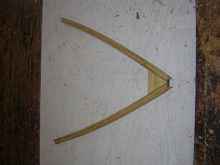 |
Ribs |
The joining floor pieces were added after and limbers and keel
bevels cut. The frames were then pre-finished with epoxy.
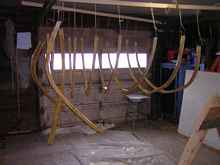 |
Sealing Ribs |
The keel and keelson came from a single piece of locust 12'
long, 12" wide at one end and 6" at the other.
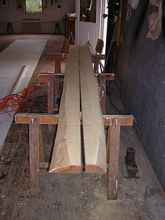 |
Locust |
It was cut lengthwise 6" tapering to 3'' and then resawed
and scarfed.
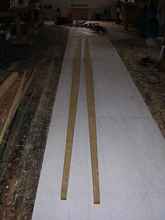 |
Keel and keelson |
The original 10/4 plank weighed 95 #. The centerboard slot was
cut in the keelson and the inner and outer stem laminates made
up on the lofting floor.
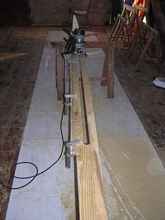 |
Centerboard slot |
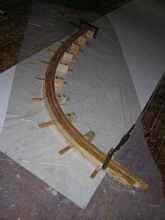 |
Inner and outer stems |
With the frame and keelson set up and the end stems glued on,
the next big decision was lining out the lapstrake planks.
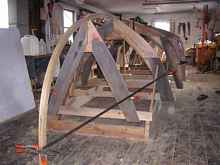 |
Mold 4 |
Iain Oughtred gives several formulas in his book ("Clinker
plywood boatbuilding manual") that proportion
the planks in decreasing width from garboard to sheerline. I made
eight 3/4" x 1" spruce battens 32' long that I used
to visualize the layout. Lots of fiddling ensued. In the first
attempt the garboard twists down slightly at the second to last
frame; I think it looks better in the second attempt below.
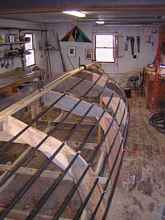 |
Garboard |
Getting it all to look right takes some time. I spent quite
a lot of time just looking (ie weeks), standing off to the side,
opening the door and walking outside, even looking thru the framework
to see the lines from the inside.
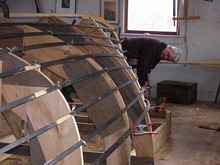 |
Viewing the lines |
To quote Iain, "In the end, the only rule is to get it
looking good. The problem with this, as John Gardner points out,
is that it depends on who is doing the looking." Here are
photos of the final decision.
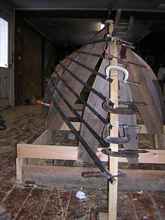 |
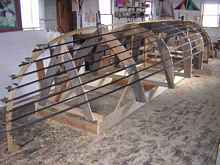 |
Now on to the sail design. Ansel gives details on eight traditional
rigs varying in size from 110 to 352 sq ft. Most of these are
sloops: sprit, lug or gaff. In looking at these rigs I worried
that the large main sail, with a 20' mast, would be more than
a handful for people who weren't born with a harpoon in their
hands. I decided to divide the rig up to lower the heeling angle
and make the individual sails smaller. My original idea was to
do a schooner rig, but the narrow ends of the whaleboat do not
allow for a good sheeting angle for a large aft sail. So I turned
to Culler's discussion of the cat ketch rig ( ("Pete
Culler on wooden boats") This type of design
was seen on many traditional boats including the hampden boats
of Maine and the spithead wherrys of England. Culler's plan allows
for easy sail reduction in varying conditions: with all sail up,
the first reduction strikes the mizzen and moves the main aft
to another step. As wind increases further the main comes down,
and the mizzen goes up in its place.
Culler liked the sprit rig, and I have been using a sprit sail
on my catspaw dinghy for 20 years. They are simple to set up,
and the most powerful sail type for the length of their spars.
Bolger in "100
small boat rigs" discusses them at length. I
thought they would be well suited for the whaleboat, and when
struck, could be set down in the middle of the boat without interfering
with the rowers. In the whaleboat rowers sit outboard, opposite
their oarlocks.
I made a 1"-1' scale drawing of the profile of the boat
and fiddled around with various square footages using the formulas
from Nichol's book (Working
guide to traditional small boat sails), eventually
arriving at the sail design photo below.
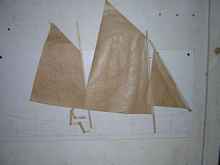 |
Sail design |
A scale stick figure sits on the aft rowing thwart #5, the mainmast
is on thwart #1, and the mizzen on #4. In this full sail setting,
the main can be brailed up quickly leaving the boat either hove-to
or sailing with jib and mizzen. No shrouds or stays are needed.
The main is 120, the mizzen 70 and the jib 35 sq ft. The main
over laps the mizzen and is boomless. My sailmaker does not care
for this arrangement but it was commonly found in working boats
and as a friend has pointed out: "the men who did that work
were not fools". I worked out the lead for the various reefing
configurations and they all fall within 5% of the CL. Bolger notes
the lead is less important in long keeled boats, and, in all of
Ansel's sail plans the lead is near zero.
With this plan the sheeting angle for the main falls just aft
of the stick figure, and the sheet for the boomed mizzen is inboard
as well. The first reef will bring down the jib, the second will
reef the main, the third will be a reefed main in the second mast
position at thwart #3, and the last will be the mizzen alone at
thwart 3 (probably a good time to be heading into harbor). The
mainmast is 16' long and setting it up is made easier by a custom
mast gate made for
me by Classic Marine. This gate is fixed on the thwart with the
hinge forward; the mast is inserted in the hole and walked up
into position. The one remaining worry is the difficulty of reefing
the main sprit sail. Reefing is a serious fault of the sprit;
even in my little catspaw wrestling with the 12' sprit can be
an adventure. What would it be like with twice the length and
twice the sail area too? One solution would be to simply brail
the main and bring it down into the boat to reef while heaving-to
under mizzen and jib. Another is to adopt one of the many variations
that have been tried to make reefing easier, all of which complicate
the essential simplicity of the sprit design. I have an idea,
which I have yet to try, to put the sail on a track and to arrange
the snotter so that it does not encircle the mast; then, with
the sail brailed, the snotter and sail can be lowered and tied
in without becoming entangled.
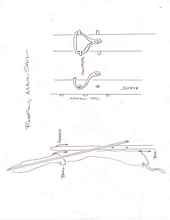 |
Reefing |
I still have moments where is think I should use a lugsail but
I have not found an arrangement with these that fits so well into
the hull.
Next time: 28' planks out of 8' plywood
*****

|

